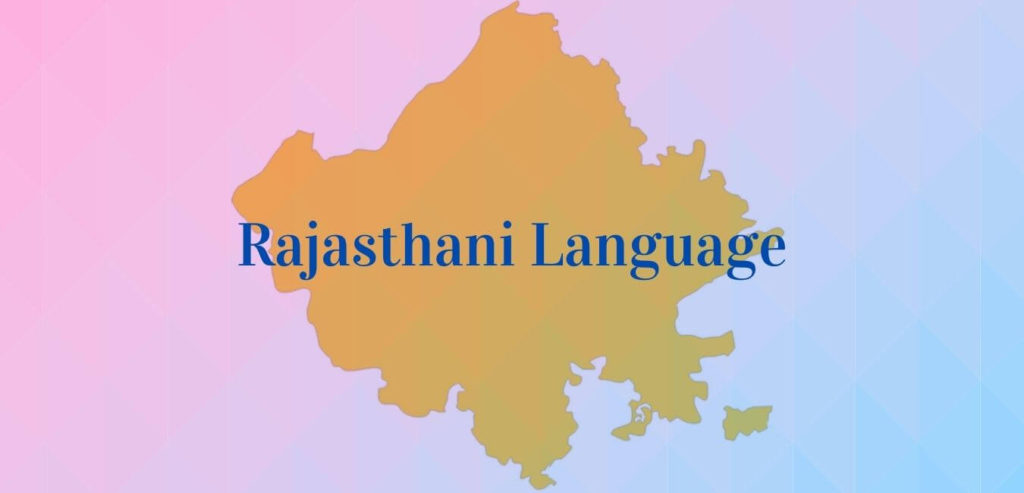The language of Rajasthan is Rajasthani, an important language of Indo-Aryan family. It is spoken by around eighty million persons in Rajasthan and other states of India, and has eight major dialects, along with some “minor dialects” including.
Rajasthani was mentioned for the first time as ‘marubhasha ‘among the list of 18 local languages mentioned in the “kuvlaymala” written by Udyotan Suri in 913 AD.
“RAJASTHANI” word for the state language was used for the first time by George Abraham Grierson in the linguistic survey of india in 1912 AD.
Origin & Evolution of Rajasthani language:
- It is believed that out of three apabrahmasha languages – marugurjari apabrahmasha had a major impact on rajasthani language in its earliest phase and marubhasha(rajasthani) evolved out of it (other two being surseni and naagar apabrahmasha).
- Rajasthani Language is an Indo-Aryan language having its roots in Vedic Sanskrit and Sauraseni Prakrit.
- Suaraseni Prakrit – initially language of Mathura region – spread westwards (towards modern Gujarat & Saurashtra) and developed modification and called Gurjara Apabhramsa or Gurjari
- From Gurjari developed Maru-Gurjar, a common language of Rajasthan & Gujarat. It started taking definite linguistic pattern from 1050 AD.
- From 1450, Rajasthani & Gujarati, started to get differentiate and in subsequent centuries distinct Rajasthani language (Maru-Bhasha) (Dingal) developed.
- From 16th century onwards it started developing as an independent language.
- In eastern region Dingal mixed with Braj-bhasha of Mathura and formed
- While Dingal was used for composing songs for war & ceremonies, Pingal was used for composing poems of love & devotional nature.
- The use of Dingle & Pingal continued freely for 4 centuries (15th-19th) but from 1818 Rajasthani language declined.
- Why? Development of Khadi boli (both language & literature)
Salient Features of Rajasthani Language:
- Rajasthani is name given to group of dialects spoken in Rajasthan.
- George Abraham Grierson (1908) was the first scholar who gave the nomenclature ‘Rajasthani’ to the language, which was earlier known through its various dialects.
- Recognized as a distinct literary language by Sahitya Academy (National Academy of letters) & University Grants Commission (UGC).
- Script is Devanagri.
- 10 vowels and 31 consonants.
- Two genders
- Fund of folk literature consisting of ballads, songs, proverbs, folk tales and panegyrics.
- In 2003 the Rajasthan Legislative Assembly – passed a unanimous resolution to insert recognition of Rajasthani into the Eighth Schedule of the Constitution of India. Present Status: Not included.
- Reasons for less propagation: lack of comprehensive reference grammar and latest dictionary prepared based on a thorough linguistic survey of Rajasthan.
Dialects of Rajasthani:
- Marwari –
- Mewari –
- Spoke in Mewar region primarily Udaipur, Chittorgarh , Rajsamand and Bhilwara.
- It has two variants “pahadi mewari”(hilly areas) and “maidani Mewari”(in the plains).
- Dhundhari –
- Dhundhari is the 2nd most spoken dialect of Rajasthan Language.
- Related to the ancient region of dhundad (amer).
- The dialect has an impact of gujarati language in it ( the usage of word “che” is common in areas where it is spoken – Jaipur , Dausa , bagru and dudu )
- Sub dialects are – torawati , nagarchal and rajavati.
- Mewati –
- Spoken mainly in Mewat Region – North east of Jaipur – Alwar region
- Spoken mainly by the “mev” community of alwar and bharatpur
- Harauti –
- Spoken in Bundi, Kota, Tonk, Jhalawar & Baran – region
- The usage of gujarati word “che” is common in this dialect as well.
- Malvi –
- Related to the ancient malwa region of madhyapradesh
- parts of Jhalawar/Kota – near to Malwa of MP
- Sub dialects are – Raangadi and Nimadi
- Nimadi – north Nimach and Bhansawar
- Vaagdi
- Spoken in the vaagad area of dungarpur and banswara
- Bagri – Northeastern Churu
- Bhili – by bhils – Dungarpur
- Shekhawati
- Related to churu , jhunjhunu hanumangarh, suratgarh and ganganagar.
- Minor Dialects:
- Minor Rajasthani Dialects are Dhatki, Godwari, Gujari, Gurgula, Goaria, Lambadi, Sansiboli, Kanjar Boli, Pardi, Gujuri, Lambadi, Bawari, Loari, Gawaria and Bishnoi Boli.
Scripts of Rajasthan Language
Rajasthani language has two scripts – Mudia and Devnagari Script.
Sahitya Academy Winners for Rajasthani Language:
| Year | Person | Literature |
|---|---|---|
| 2015 | Madhu Acharya | Gawaad (Novel) |
| 2014 | Rampal Singh Rajpurohit | Sundar Nain Sudha |
| 1975 | Mani Madhukar | Pagfero (Poetry) |
| 1974 | Vijaydan Detha | Batan Ri Phulwari Vol. X (Folk-tales) |
Prominent Linguist of Rajasthani:
- Kan Singh Parihar: English, Sanskrit, Hindi, Marwari, Rajasthani, 1940
- Anvita Abbi: Bagri, 1993
- Christopher Shackle: Bagri and Saraiki, 1976
- David Magier: Marwari, 1983
- George Abraham Grierson : Almost all the dialects of Rajasthani, 1920
- George Macalister: Dhundhari and Shekhawati, 1892
- Gopal Parihar: Bagri, 2004–present
- John D. Smith: Rajasthani, 1970–present
- J. C. Sharma: Gade lohar, Bagri or Bhili, Gojri, 1970–present
- Kali Charan Bahl: Rajasthani, 1971–1989
- K. C. Agrawal: Shekhawati, 1964
- L. P. Tessitori: Rajasthani and Marwari, 1914–16
- Lakhan Gusain: all the dialects of Rajasthani, 1990–present
- Liudmila Khokhlova: Rajasthani and Marwari, 1990–present
- Narottam Das Swami: Rajasthani and Marwari, 1960
- Peter E. Hook: Rajasthani and Marwari, 1986
- Ram Karan Asopa: Rajasthani and Marwari, 1890–1920
- Sita Ram Lalas: Rajasthani language, 1950–1970
- Saubhagya Singh Shekhawat Rajasthani, : Rajasthani Shabd-Kosh part I Sanshodhan Parivardhan, 1945–present
- Suniti Kumar Chatterjee: Rajasthani, 1948–49
- W.S. Allen: Harauti and Rajasthani, 1955–60
Rajasthani Language in Recent NEWS:
- Development of Unicode: The Rajasthan State government is developing a unified unicode of Rajasthani languages for international recognition. The initiative will also help in the claim to get it included in the Eighth Schedule of the Constitution. Read More
